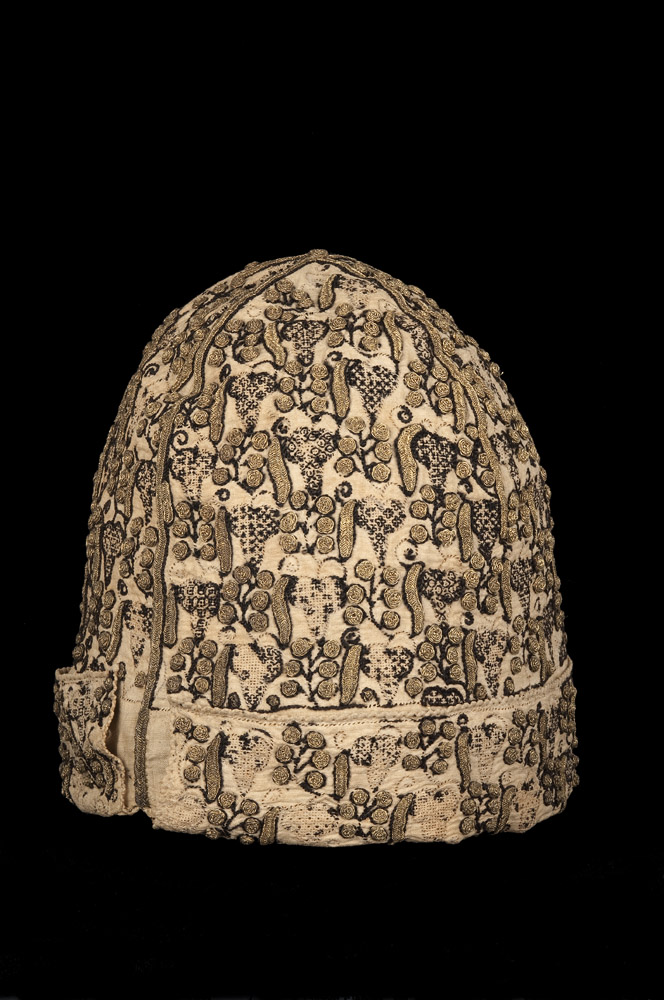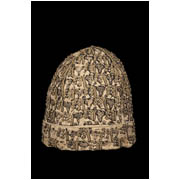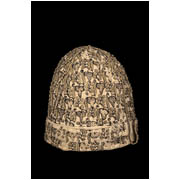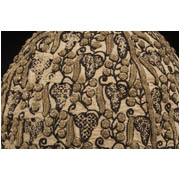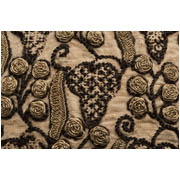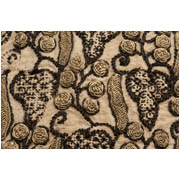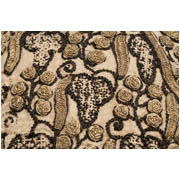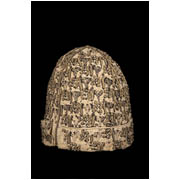Details
- Object type
cap; nightcap
- Place Associated
England (place of manufacture)
- Date
circa 1600-1620
- Materials
linen, silk, silver-gilt, hand-stitched
- Dimensions
overall: 200 mm x 180 mm x 180 mm
- Description
-
Man's cap or nightcap in linen (30 threads per cm ) embroidered in blackwork with black silk and silver-gilt threads worked in cross, plaited braid and stem stitch with a regular pattern of berries or seeds, pods and leaves. Cut in four conical panels with high crown and turned back brim with the pattern duplicated on each. Main design worked in stem stitch using black silk thread, the leaves in-filled with cross stitch using black silk thread and seed pods in plaited braid stitch in silver gilt threads.
Traditionally plain linen nightcaps were worn in bed at night. However, at the end of the 1500s and into the early 1600s embroidered nightcaps became popular. Their name of these embellished caps is a misnomer as these nightcaps were not worn in bed, but were a type of informal undress wear known as dishabille, a relaxed dress style worn at home. According to contemporary etiquette ladies and gentleman wore dishabille in private at home and dressed in such could only have visitors who were close personal friends of an equal or lesser rank, or trades people. When entertaining guests of a higher social standing the host family were required to wear formal dress. According to this tradition embroidered nightcaps should only have been worn by gentlemen at home in the privacy of their parlour or later in the century in their cabinet, the precursor of a library or study. Nevertheless, in first two decades of the seventeenth century it was noted that some gentlemen wore these embellished nightcaps in public in the city of London and even at the Royal court. Orazio Busino (fl.1617–21), the chaplain to the new Venetian ambassador who was presented to James VI and I (1566–1625) in 1617 wrote in Anglipotrida, 1618, that in the King’s presence chamber ‘[o]ccasionally some of the chief lords and the favourite wear on their heads richly embroidered caps there under the pretence of having some imaginary indisposition’.
As nightcaps did not need to be individually tailored to individuals they were not made bespoke to order but could be purchased ready-made. Frances Seymour, Countess of Hereford (1578–1639), instructed her steward in 1603 to visit the best embroiderer of nightcaps ‘Mrs Price in the Strand’ and buy a ‘very fair one and not grossly wrought’ of ‘black silke and golde and silver’. In 1629 an Oxford student, William Freke, bought a ‘blackwork and gold cappe’ for 17s 6d, the equivalent of three weeks pay for a professional embroider.
This nightcap is embroidered with a monochromatic design in black silk thread is known as blackwork. This style is thought to have originated in North Africa with early surviving examples from Egypt dating to the Mamluk period (1250–1517), including textile fragments in the Yousef Jameel Centre for Islamic and Asian Art, Ashmolean Museum, Oxford (for example EA1993.152). The Umayyad Caliphate introduced the style to Spain where by the late 1400s it had spread from Mudéjar art into court dress. One of the earliest formal portraits depicting its use is Juan de Flandes, Isabel of Castille, circa 1500–04 (Palacio Real, Madrid). Isabel's daughter, Catherine of Aragon (1485–1536), is said to have introduced the style to England when she married Arthur Tudor (1486–1502), Prince of Wales, son of Henry VII (1457–1509), in 1501. Often referred to in England as Spanish work at this date, it can be seen decorating shifts in several early Tudor court portraits by Hans Holbein the Younger (circa 1497–1543) and his peers. By the late 1600s it was also being used to decorate accessories, main garments and domestic textiles.
Provenance: Major WG Townsend Currie; Frank Partridge & Sons, London; from whom purchased by Sir William Burrell on 22 January 1943 for £18.
- Credit Line/Donor
Gifted by Sir William and Lady Burrell to the City of Glasgow, 1944
- Collection
Burrell Collection: British Embroideries
- ID Number
29.132
- Location
In storage
- Related People
Frank Partridge & Sons dealer
